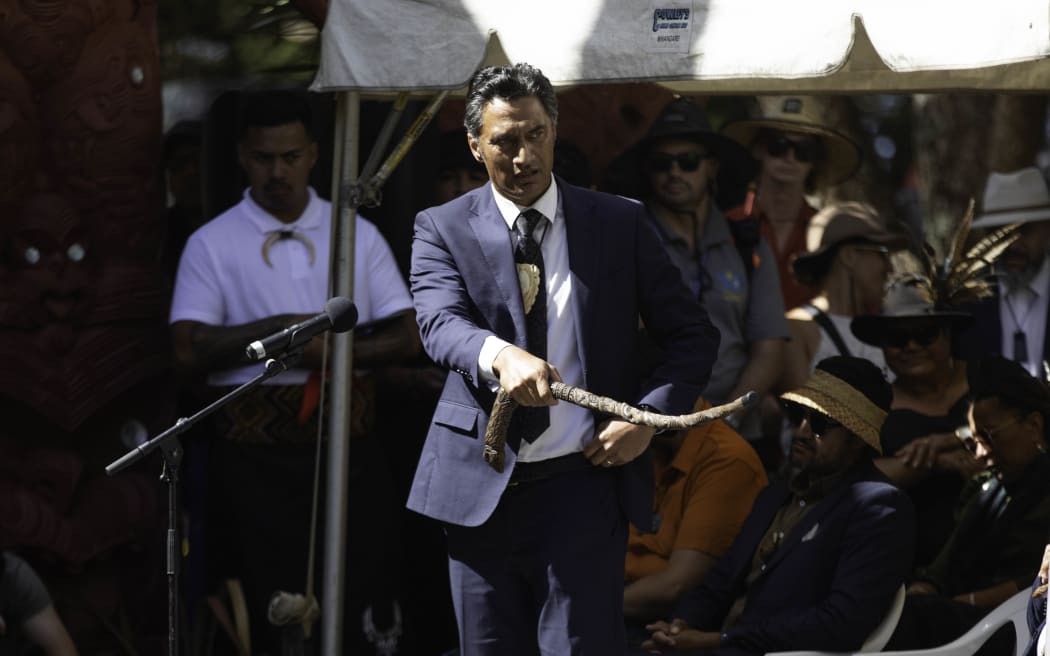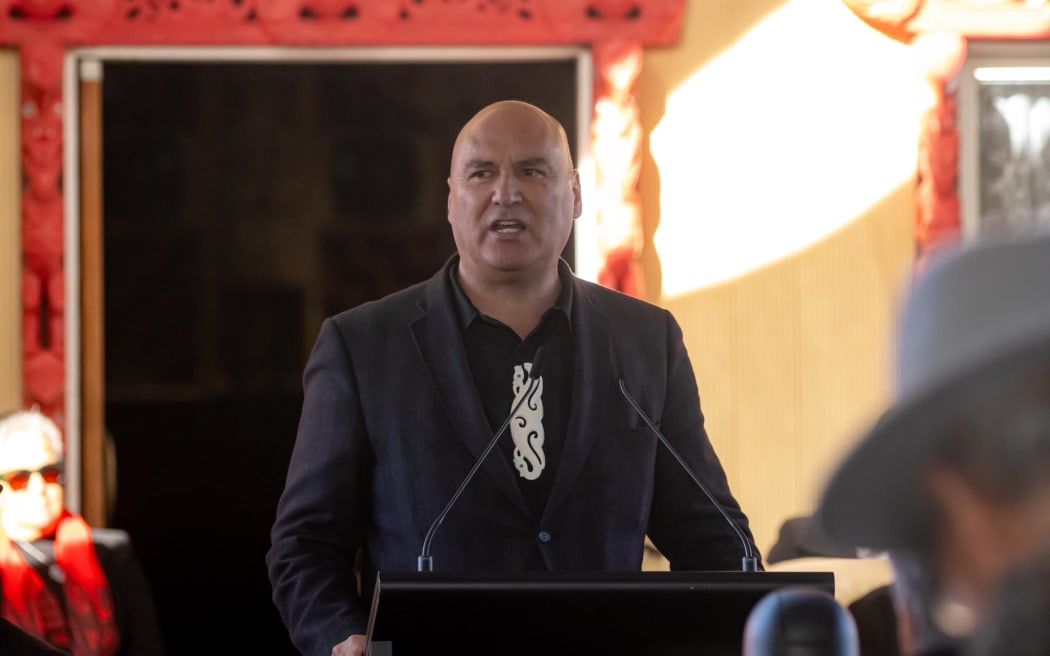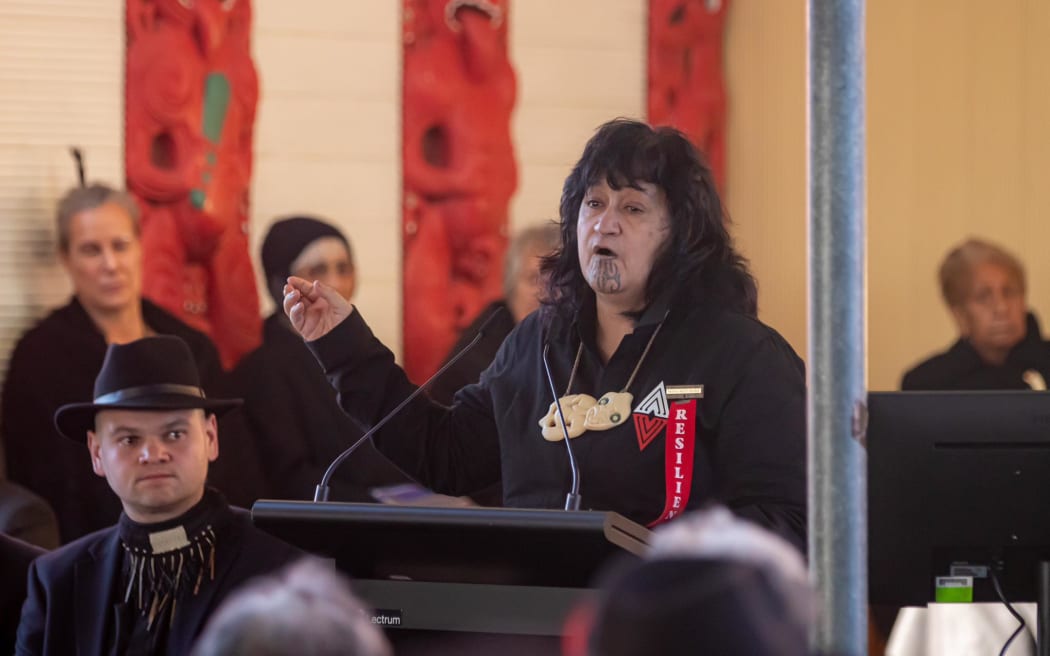Māori parliament workings discussed at Hui Ā Motu second phase

Hundreds of Māori gathered at Ōmāhu Marae near Hastings, fresh off the heel of a nationwide protest, to discuss ways to unify under the current government.
‘Kotahitanga’ was the theme of the second national hui this year following one at Ngāruawāhia.
Among those in attendance are Kiingi Tuuheitia, Rātana Church tumuaki Manuao Te Kohamutunga Tamou and Sir Robert ‘Bom’ Gillies, the last surviving soldier of the 28th Māori Battalion.
Iwi leaders and their uri from across the country arrived for the pōwhiri before 9am.
Once formalities had finished, several speakers took over the taumata, sharing their whakaaro late into the afternoon.

Ngāti Kahungunu chairperson Bayden Barber, whose iwi hosted the event, spoke first, laying down the kaupapa for the hui – how can Māori unify and organise themselves within a system separate from the Crown?
He shared some details of a potential Māori parliament, which he said would be modelled on the Māori parliament which first stood at Waipatu Marae in Hastings in 1892.
Māori held their future in their own hands, he said.
“It’s time we organise ourselves nē, we need to organise ourselves koira tō tātou nei mahi i te rā nei.”
The parliament would include an upper and lower house with traditional leaders – like Kiingi Tuuheitia sitting above acting as spiritual guidance, Barber said.
The government still had an important part to play in Māori affairs, as seen with the Budget, he said.

Ngāti Toa Rangatira chief executive Helmut Modlik was next and introduced his plan for a Federation of Māori Tribes.
Modlik’s presented commentary on his discussion document Towards a Māori Nation, an early draft of a federal model of governance.
“As the coalition came to power, we were all shocked at how quickly and callously decades of struggle and mahi to pursue justice, equity, resources for our people were swept away.
“If our tūpuna had the will, the wisdom and resources, to bind themselves together they wouldn’t have lost anything. Nothing would have gone, but here we are today.
“It must be an inclusive vision. It must be one based on the framework of: tika, pono, rangimārie, kotahitanga.”

Taking to the lectern, Māori lawyer Annette Sykes criticised the models for being too similar to those formulated in Western countries.
“You cannot dismantle the coloniser’s house with the coloniser’s tools,” she said.
“One of the key issues, tane mā, is looking at models from Pākehā and emulating those models and trying to say they are ours. We’ve got to [go] further back than that.
“We have to ask ourselves, ‘Do we need a whare paremata? Or do we need something more?”
Other iwi leaders stood and gave their whakaaro on what governance meant to them.
Māori politicians from Labour and the Green Party gave their stance on achieving Māori sovereignty.
Ikaroa-Rawhiti MP Cushla Tangaere-Manuel said it was a privilege to be there.
“While I do represent the Labour Party, I come here as someone with Māori blood coursing through my veins.
“Whanau, we need to vote. We need to vote for governments who are sympathetic to Māori. For now, that is my job.”
Huhana Lyndon from the Greens acknowledged Thursday’s nationwide hīkoi movement.
“We feel embattled, we feel as though our voices have not been heard, as we see successive legislations passed through under urgency: fast track, 7AA, growing Waikeria prison. You name it, we’re getting it.
“I acknowledge all of our whānau who stood in the streets, drove in the cars, and rallied around the motū. That was a clear sign that things are not okay.”
Speaking to media before standing on the taumata, Māori Development Minister Tama Pōtaka said he was supportive of the ‘carkoi’ movement.
“I think it’s great people can come together with a kaupapa. Whether or not I agree with all the concerns, or whether I think those concerns are well-evidenced is a different question. I tautoko that.
“Certainly, my focus was on the budget. Got through the budget, went to Tāmaki and then came to listen to the kōrero here. So far, it’s been excellent.”
Finishing the hui, Kiingi Tuuheitia thanked Ngāti Kahungunu for hosting the event.
Tuuheitia shared his experience travelling to Hawke’s Bay post Cyclone Gabrielle.
“We were driving past these houses after the floods … Just down the road here, the whānau was left with nothing. This young fella waves us down. My car stops. My driver pulls over and he passes us some smoked eel.
“He lost everything but he still wanted to give us something.”
That was mana motuhake, he said.
Speaking to RNZ, Barber said he was confident those who attended would eventually join some sort of unified Māori alliance.
“I think people like the idea of coming together. It’s always a challenge to try and do these things. A lot of models and whakaaro to mull over,” he said.
“We got to the crux of the kaupapa. The kōrero we had was high quality. I was very happy.”
According to the news on Radio New Zealand




